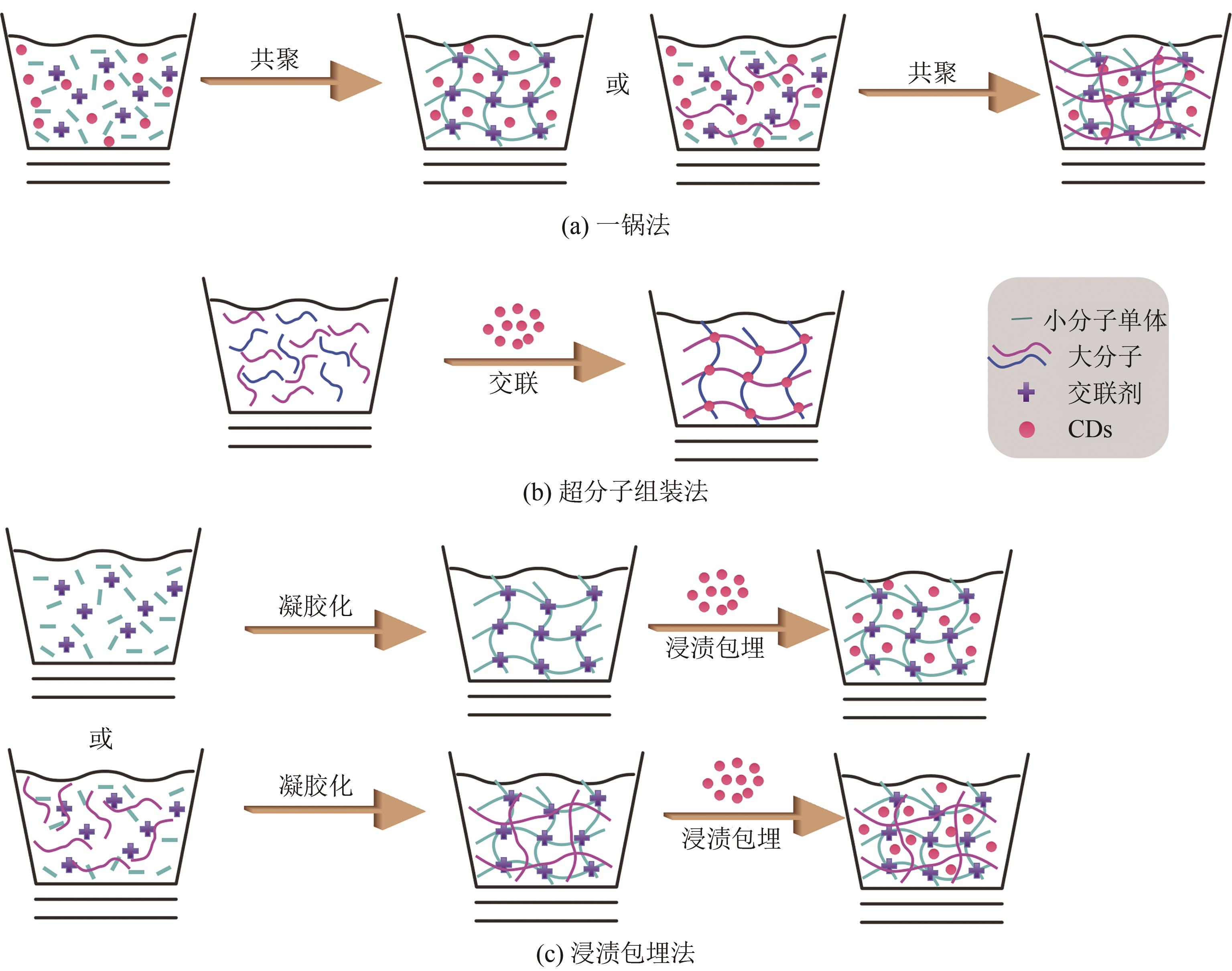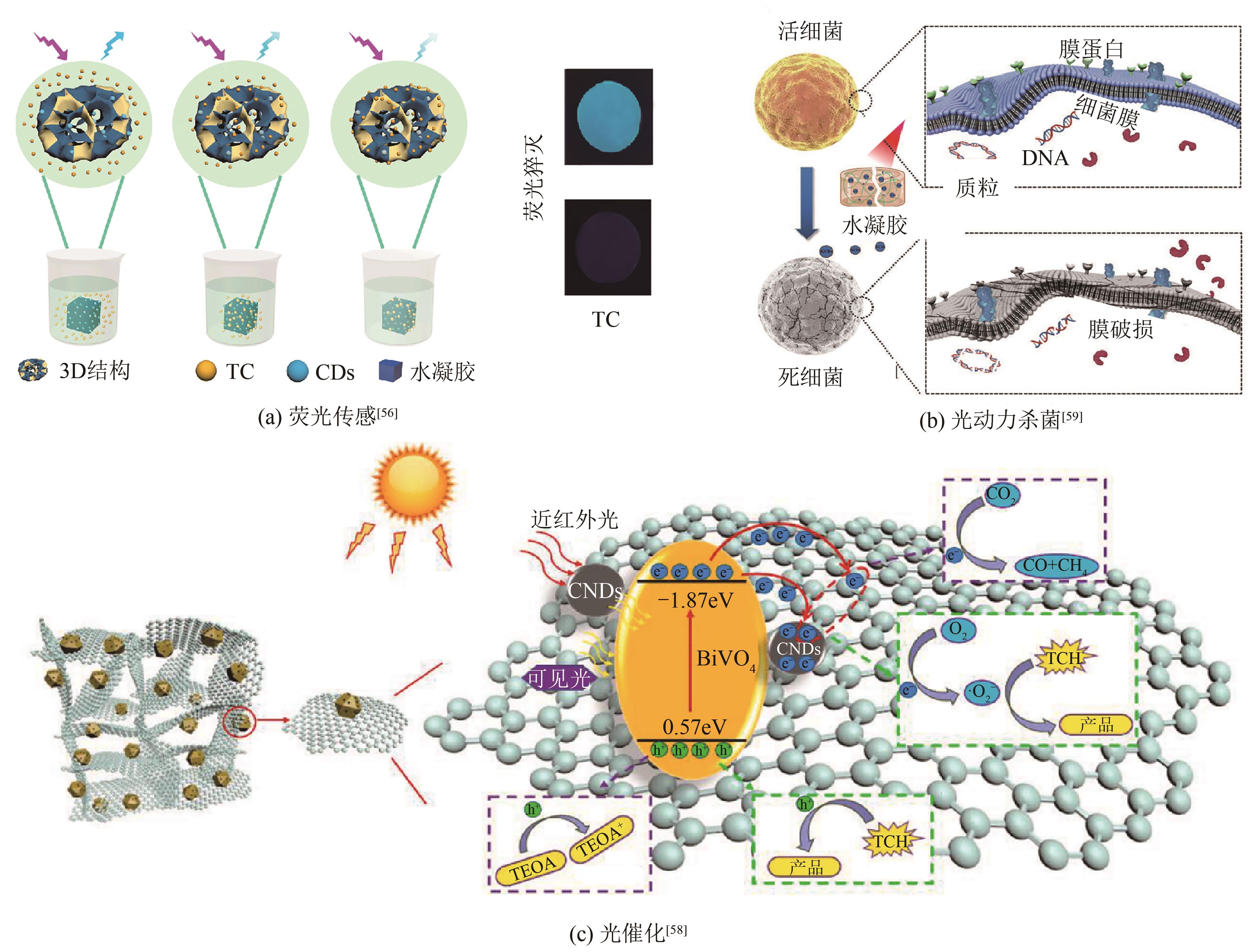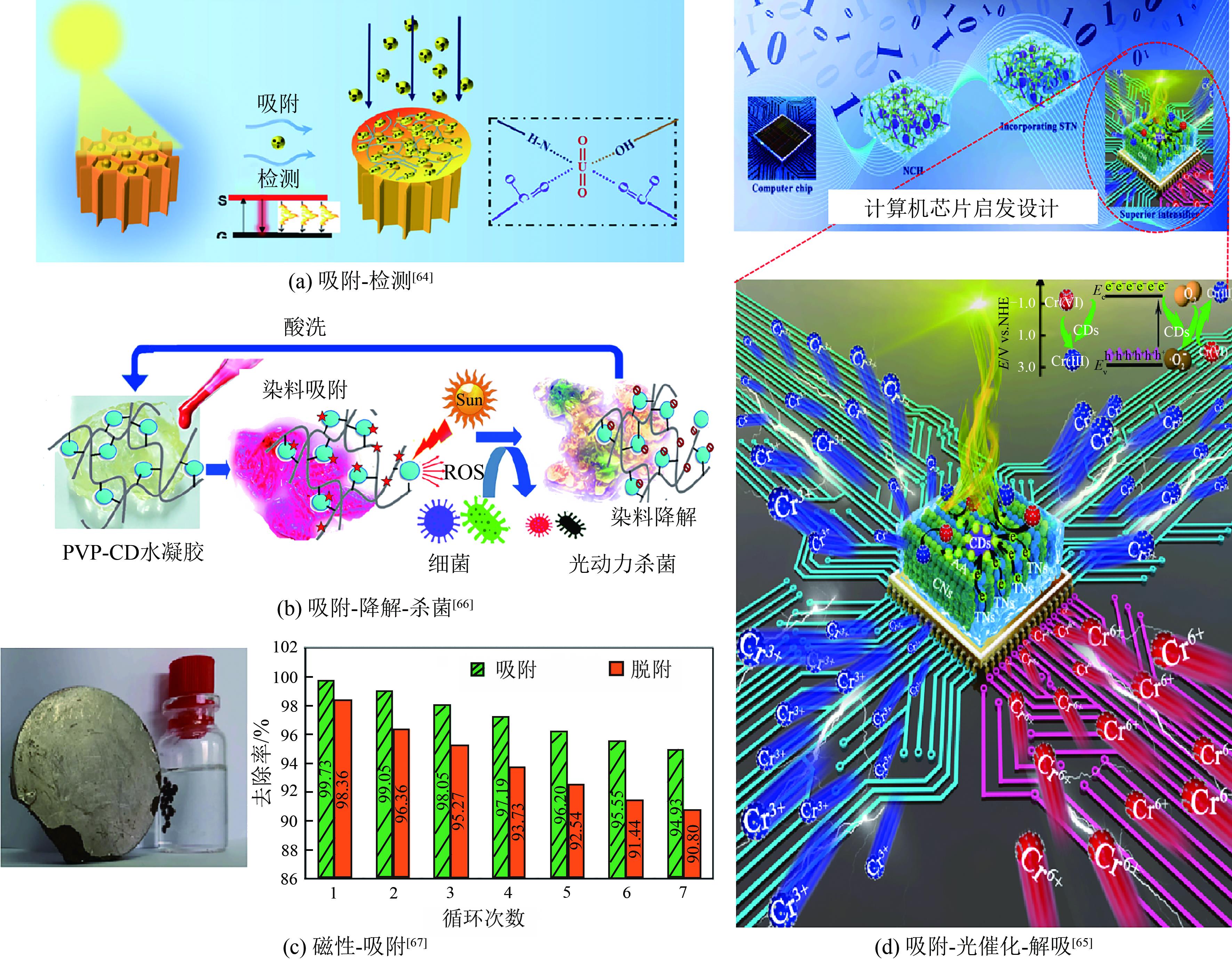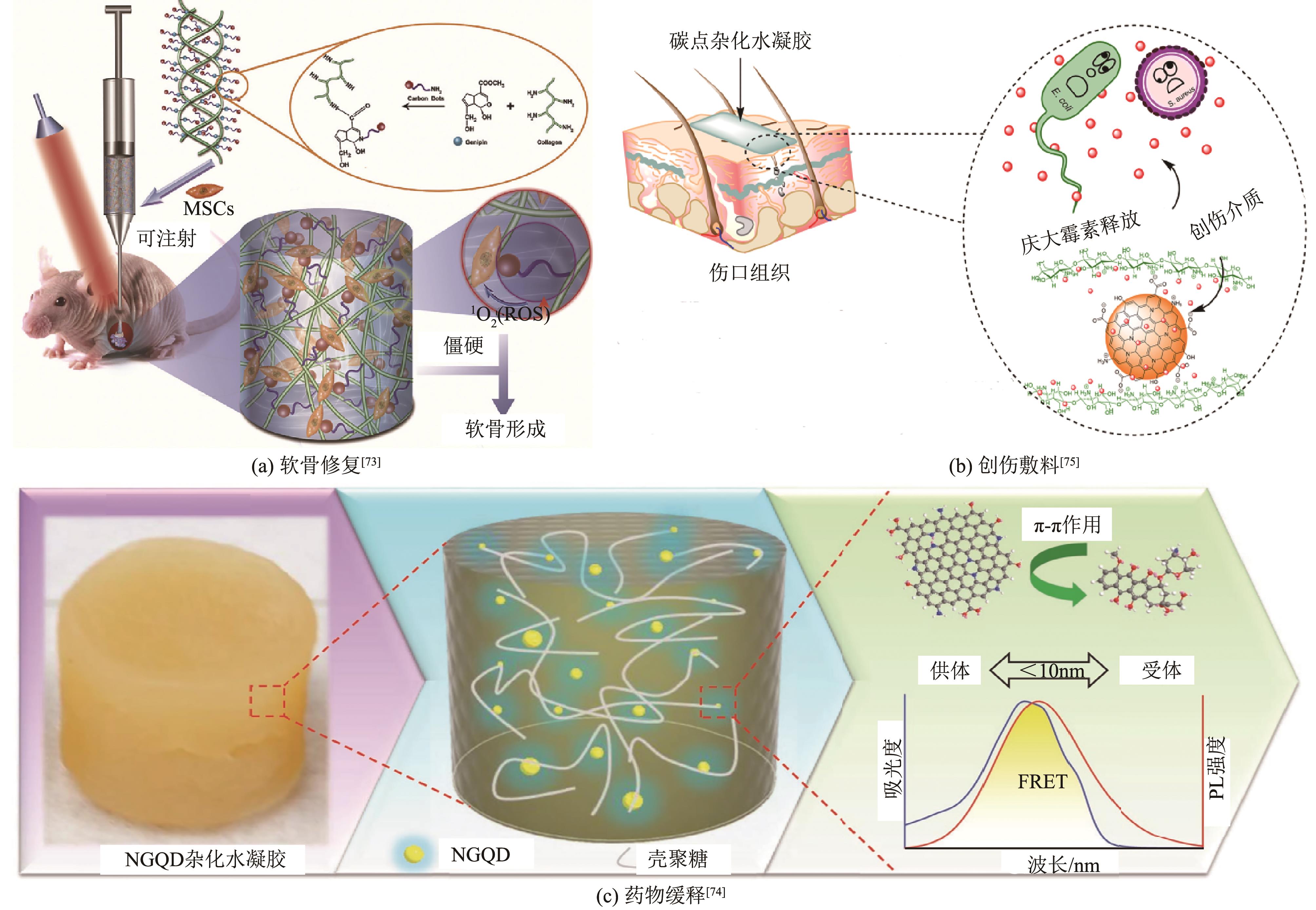Chemical Industry and Engineering Progress ›› 2025, Vol. 44 ›› Issue (1): 305-318.DOI: 10.16085/j.issn.1000-6613.2023-2222
• Materials science and technology • Previous Articles Next Articles
Preparation and application of carbon dots hybrid hydrogels
WANG Xiangpeng1,2,3( ), ZHENG Yunxiang2, ZHANG Chunxiao2,3, CHEN Chunmao1(
), ZHENG Yunxiang2, ZHANG Chunxiao2,3, CHEN Chunmao1( )
)
- 1.College of Chemical Engineering and Environment, China University of Petroleum, Beijing 102249, China
2.School of Chemical Engineering, Shandong Institute of Petroleum and Chemical Technology, Dongying 257061, Shandong, China
3.Engineering Research Center for Carbon Neutrality Green Energy Technology of Universities in Shandong Province, Dongying 257061, Shandong, China
-
Received:2023-12-19Revised:2024-06-25Online:2025-02-13Published:2025-01-15 -
Contact:CHEN Chunmao
碳点杂化水凝胶的制备及应用
王向鹏1,2,3( ), 郑云香2, 张春晓2,3, 陈春茂1(
), 郑云香2, 张春晓2,3, 陈春茂1( )
)
- 1.中国石油大学(北京) 化学工程与环境学院,北京 102249
2.山东石油化工学院化学工程学院,山东 东营 257061
3.山东省高校碳中和绿色能源技术工程研究中心, 山东 东营 257061
-
通讯作者:陈春茂 -
作者简介:王向鹏(1989—),男,博士研究生,副教授,研究方向为水凝胶制备与改性。E-mail:wangxiangpeng1989@163.com。 -
基金资助:东营市科学发展基金(DJ2023006);山东省大学生创新创业训练计划(S202313386029);山东石油化工学院化学工程学院重点科研项目(HYKY2023001)
CLC Number:
Cite this article
WANG Xiangpeng, ZHENG Yunxiang, ZHANG Chunxiao, CHEN Chunmao. Preparation and application of carbon dots hybrid hydrogels[J]. Chemical Industry and Engineering Progress, 2025, 44(1): 305-318.
王向鹏, 郑云香, 张春晓, 陈春茂. 碳点杂化水凝胶的制备及应用[J]. 化工进展, 2025, 44(1): 305-318.
share this article
Add to citation manager EndNote|Ris|BibTeX
URL: https://hgjz.cip.com.cn/EN/10.16085/j.issn.1000-6613.2023-2222
| 类型 | 制备方法 | 工艺特点 | CDs结构特征 | 参考文献 |
|---|---|---|---|---|
| 自上而下 | 电弧放电法 | 电弧放电法是最早制备CDs的方法,通过弧光放电使碳材料热解、炭化。优点是原料适应性广,制得的CDs荧光性能较好;缺点是产率低,仅占悬浮液的10%(质量分数)左右,纯化过程复杂,不利于产物的收集;能耗高,难以工业化 | 粒径小(1~5nm)但不均匀,荧光性能好但不易纯化,易溶于水,氧含量高,无须进行表面修饰就能发出荧光 | [ |
| 激光刻蚀法 | 通过激光束对碳源进行照射消蚀,将碳纳米颗粒从碳源上剥落下来,从而获得CDs。优点是通过简单调节激光器脉冲能量和时间可以调控CDs的大小和荧光量子效率;缺点是所用仪器昂贵、合成过程复杂、产率低以及杂质多等,因此该法较少使用 | 尺寸小,可调性强,荧光性能好,具有良好的稳定性和出色的抗干扰性能,粒径均匀性差 | [ | |
| 电化学法 | 强电场作用下将工作电极的大块碳材料剥离而制备CDs。优点是通过调整电极电势与电流密度能精确控制CDs的合成,且对碳源的利用率较高;缺点是碳源前期处理工作烦琐耗时,后期CDs的纯化所需透析等步骤的耗时较长,杂原子掺杂选择有限 | 呈均匀球状,粒径较小,粒径分布较窄,均匀性好,稳定,荧光效应较强 | [ | |
| 化学氧化法 | 化学氧化法是利用强氧化剂氧化切割大块碳材料制备出CDs,操作简单,成本低,收率高,易大规模生产,但需用到强氧化剂,存在安全隐患 | 荧光寿命长,结晶度好,粒径分布窄,直径1~3nm,无需表面修饰即可发光 | [ | |
| 自下而上 | 微波法 | 微波法主要是利用微波消解碳前体来制备CDs。优点是操作简便、快捷,可扩展性强,成本低;缺点是所得CDs粒径分布不均匀,需进一步分离 | 水溶性好,荧光稳定,纯度高,粒径均匀性差 | [ |
| 模板法 | 模板作为支撑材料合成CDs后再将模板除去,该方法能有效防止CDs在高温处理过程中发生团聚。优点是操作简单,设备易得;缺点是纯化时较复杂和困难,模板除去时可能会对CDs的性质产生不利影响 | 粒径均匀,水溶性好,荧光效应较强,表面有羟基、羧基等官能团,生物毒性低,尺寸、成分和结晶度可调 | [ | |
| 水热法 | 水热法是目前最常用的制备CDs的方法之一,将含碳前体在高温高压下直接通过水热反应制备CDs,合成过程简单,且粒径较为均匀,可在一步反应中进行表面修饰,利于大量生产 | 水溶性好,表面官能团丰富,尺寸小,粒径分布均匀,荧光稳定 | [ | |
| 固相法 | 含碳前体在固相介质中发生反应,反应条件易于控制,能实现高产率制备CDs,避免了合成过程中有机试剂的使用,因此对环境无害,但反应速率难以控制 | 良好的水溶性、光稳定性和高离子强度的稳定性,但粒径分布不均匀 | [ |
| 类型 | 制备方法 | 工艺特点 | CDs结构特征 | 参考文献 |
|---|---|---|---|---|
| 自上而下 | 电弧放电法 | 电弧放电法是最早制备CDs的方法,通过弧光放电使碳材料热解、炭化。优点是原料适应性广,制得的CDs荧光性能较好;缺点是产率低,仅占悬浮液的10%(质量分数)左右,纯化过程复杂,不利于产物的收集;能耗高,难以工业化 | 粒径小(1~5nm)但不均匀,荧光性能好但不易纯化,易溶于水,氧含量高,无须进行表面修饰就能发出荧光 | [ |
| 激光刻蚀法 | 通过激光束对碳源进行照射消蚀,将碳纳米颗粒从碳源上剥落下来,从而获得CDs。优点是通过简单调节激光器脉冲能量和时间可以调控CDs的大小和荧光量子效率;缺点是所用仪器昂贵、合成过程复杂、产率低以及杂质多等,因此该法较少使用 | 尺寸小,可调性强,荧光性能好,具有良好的稳定性和出色的抗干扰性能,粒径均匀性差 | [ | |
| 电化学法 | 强电场作用下将工作电极的大块碳材料剥离而制备CDs。优点是通过调整电极电势与电流密度能精确控制CDs的合成,且对碳源的利用率较高;缺点是碳源前期处理工作烦琐耗时,后期CDs的纯化所需透析等步骤的耗时较长,杂原子掺杂选择有限 | 呈均匀球状,粒径较小,粒径分布较窄,均匀性好,稳定,荧光效应较强 | [ | |
| 化学氧化法 | 化学氧化法是利用强氧化剂氧化切割大块碳材料制备出CDs,操作简单,成本低,收率高,易大规模生产,但需用到强氧化剂,存在安全隐患 | 荧光寿命长,结晶度好,粒径分布窄,直径1~3nm,无需表面修饰即可发光 | [ | |
| 自下而上 | 微波法 | 微波法主要是利用微波消解碳前体来制备CDs。优点是操作简便、快捷,可扩展性强,成本低;缺点是所得CDs粒径分布不均匀,需进一步分离 | 水溶性好,荧光稳定,纯度高,粒径均匀性差 | [ |
| 模板法 | 模板作为支撑材料合成CDs后再将模板除去,该方法能有效防止CDs在高温处理过程中发生团聚。优点是操作简单,设备易得;缺点是纯化时较复杂和困难,模板除去时可能会对CDs的性质产生不利影响 | 粒径均匀,水溶性好,荧光效应较强,表面有羟基、羧基等官能团,生物毒性低,尺寸、成分和结晶度可调 | [ | |
| 水热法 | 水热法是目前最常用的制备CDs的方法之一,将含碳前体在高温高压下直接通过水热反应制备CDs,合成过程简单,且粒径较为均匀,可在一步反应中进行表面修饰,利于大量生产 | 水溶性好,表面官能团丰富,尺寸小,粒径分布均匀,荧光稳定 | [ | |
| 固相法 | 含碳前体在固相介质中发生反应,反应条件易于控制,能实现高产率制备CDs,避免了合成过程中有机试剂的使用,因此对环境无害,但反应速率难以控制 | 良好的水溶性、光稳定性和高离子强度的稳定性,但粒径分布不均匀 | [ |
| 类型 | 修饰方法 | 参考文献 | 类型 | 修饰方法 | 参考文献 | |
|---|---|---|---|---|---|---|
| 杂原子掺杂修饰 | N掺杂 | [ | 功能化修饰 | 羟基功能化 | [ | |
| S掺杂 | [ | 羧基功能化 | [ | |||
| P掺杂 | [ | 醛基功能化 | [ | |||
| 多原子掺杂 | [ | 多基团功能化 | [ | |||
| B掺杂 | [ | 纳米复合修饰 | 金属及金属氧化物复合 | [ | ||
| 卤素掺杂 | [ | SiO2复合 | [ |
| 类型 | 修饰方法 | 参考文献 | 类型 | 修饰方法 | 参考文献 | |
|---|---|---|---|---|---|---|
| 杂原子掺杂修饰 | N掺杂 | [ | 功能化修饰 | 羟基功能化 | [ | |
| S掺杂 | [ | 羧基功能化 | [ | |||
| P掺杂 | [ | 醛基功能化 | [ | |||
| 多原子掺杂 | [ | 多基团功能化 | [ | |||
| B掺杂 | [ | 纳米复合修饰 | 金属及金属氧化物复合 | [ | ||
| 卤素掺杂 | [ | SiO2复合 | [ |
| 1 | Deepak KASAI R, RADHIKA Devi, ARCHANA S, et al. A review on hydrogels classification and recent developments in biomedical applications[J]. International Journal of Polymeric Materials and Polymeric Biomaterials, 2023, 72(13): 1059-1069. |
| 2 | GUO Youhong, Jiwoong BAE, FANG Zhiwei, et al. Hydrogels and hydrogel-derived materials for energy and water sustainability[J]. Chemical Reviews, 2020, 120(15): 7642-7707. |
| 3 | HUANG Heyuan, DONG Zhicheng, REN Xiaoyang, et al. High-strength hydrogels: Fabrication, reinforcement mechanisms, and applications[J]. Nano Research, 2023, 16(2): 3475-3515. |
| 4 | FOUDAZI Reza, ZOWADA Ryan, Ica MANAS-ZLOCZOWER, et al. Porous hydrogels: Present challenges and future opportunities[J]. Langmuir, 2023, 39(6): 2092-2111. |
| 5 | Rashmita DAS, BANDYOPADHYAY Rajib, PRAMANIK Panchanan. Carbon quantum dots from natural resource: A review[J]. Materials Today Chemistry, 2018, 8: 96-109. |
| 6 | MOLAEI Mohammad Jafar. Principles, mechanisms, and application of carbon quantum dots in sensors: A review[J]. Analytical Methods, 2020, 12(10): 1266-1287. |
| 7 | ZHANG Likang, YANG Xue, YIN Zhifu, et al. A review on carbon quantum dots: Synthesis, photoluminescence mechanisms and applications[J]. Luminescence, 2022, 37(10): 1612-1638. |
| 8 | KUMAR Pawan, Shweta DUA, KAUR Ravinder, et al. A review on advancements in carbon quantum dots and their application in photovoltaics[J]. RSC Advances, 2022, 12(8): 4714-4759. |
| 9 | EBHODAGHE Samuel Ogbeide. A short review on chitosan and gelatin-based hydrogel composite polymers for wound healing[J]. Journal of Biomaterials Science Polymer Edition, 2022, 33(12): 1595-1622. |
| 10 | XU Hong, AN Zehua, ZHANG Haoran, et al. Preparation and characterization of a CDs based hydrogel slow-release fertilizer[J]. Materials Research Bulletin, 2024, 170: 112590. |
| 11 | CUI Fangchao, XI Liqing, WANG Dangfeng, et al. Advanced in carbon dot-based hydrogels for antibacterial, detection and adsorption[J]. Coordination Chemistry Reviews, 2023, 497: 215457. |
| 12 | WANG Yijie, Tingjie LYU, YIN Keyang, et al. Carbon dot-based hydrogels: Preparations, properties, and applications[J]. Small, 2023, 19(17): e2207048. |
| 13 | SUI Bowen, LI Yunfeng, YANG Bai. Nanocomposite hydrogels based on carbon dots and polymers[J]. Chinese Chemical Letters, 2020, 31(6): 1443-1447. |
| 14 | TIAN Lin, LI Zhao, WANG Peng, et al. Carbon quantum dots for advanced electrocatalysis[J]. Journal of Energy Chemistry, 2021, 55: 279-294. |
| 15 | RASAL Akash S, YADAV Sudesh, YADAV Anchal, et al. Carbon quantum dots for energy applications: A review[J]. ACS Applied Nano Materials, 2021, 4(7): 6515-6541. |
| 16 | F-J CHAO-MUJICA, GARCIA-HERNÁNDEZ L, CAMACHO-LÓPEZ S, et al. Carbon quantum dots by submerged arc discharge in water: Synthesis, characterization, and mechanism of formation[J]. Journal of Applied Physics, 2021, 129(16): 163301. |
| 17 | CUI Lin, REN Xin, WANG Jinggang, et al. Synthesis of homogeneous carbon quantum dots by ultrafast dual-beam pulsed laser ablation for bioimaging[J]. Materials Today Nano, 2020, 12: 100091. |
| 18 | KAKAEI Karim, KHODADOOST Somayyeh, GHOLIPOUR Maryam, et al. Core-shell polyaniline functionalized carbon quantum dots for supercapacitor[J]. Journal of Physics and Chemistry of Solids, 2021, 148: 109753. |
| 19 | DA SILVA SOUZA Débora Rosa, CAMINHAS Larissa Durães, DE MESQUITA João Paulo, et al. Luminescent carbon dots obtained from cellulose[J]. Materials Chemistry and Physics, 2018, 203: 148-155. |
| 20 | Martyna PAJEWSKA-SZMYT, BUSZEWSKI Bogusław, Renata GADZAŁA-KOPCIUCH. Sulphur and nitrogen doped carbon dots synthesis by microwave assisted method as quantitative analytical nano-tool for mercury ion sensing[J]. Materials Chemistry and Physics, 2020, 242: 122484. |
| 21 | CHERNYAK Sergei, PODGORNOVA Angelina, DOROFEEV Sergey, et al. Synthesis and modification of pristine and nitrogen-doped carbon dots by combining template pyrolysis and oxidation[J]. Applied Surface Science, 2020, 507: 145027. |
| 22 | LI Dongying, WANG Shuangpeng, AZAD Fahad, et al. Single-step synthesis of polychromatic carbon quantum dots for macroscopic detection of Hg2+ [J]. Ecotoxicology and Environmental Safety, 2020, 190: 110141. |
| 23 | ZHAO Dan, ZHANG Zhixia, LI Caimao, et al. Yellow-emitting hydrophobic carbon dots via solid-phase synthesis and their applications[J]. ACS Omega, 2020, 5(35): 22587-22595. |
| 24 | WANG Hao, GAO Peng, WANG Yun, et al. Fluorescently tuned nitrogen-doped carbon dots from carbon source with different content of carboxyl groups[J]. APL Materials, 2015, 3(8): 086102. |
| 25 | WANG Haolin, AI Lin, SONG Ziqi, et al. Surface modification functionalized carbon dots[J]. Chemistry: A European Journal, 2023, 29(65): e2302383. |
| 26 | RANGEL Miriam, SALUJA Sarvagya, BARBA V, et al. Dual-emissive waste oil based S-doped carbon dots for acetone detection and Cr(Ⅵ) detection/reduction/removal[J]. Journal of Environmental Chemical Engineering, 2023, 11(2): 109438. |
| 27 | CHEN Lanlan, ZHANG Chen, DU Zhongjie, et al. Fabrication of carboxyl group-functionalized carbon quantum dots and its transparent and luminescent epoxy matrix nanocomposites for white LED encapsulation[J]. Macromolecular Materials and Engineering, 2015, 300(12): 1232-1237. |
| 28 | KALAIYARASAN Gopi, JOSEPH James, KUMAR Pankaj. Phosphorus-doped carbon quantum dots as fluorometric probes for iron detection[J]. ACS Omega, 2020, 5(35): 22278-22288. |
| 29 | ALAVI Mehran, JABARI Erfan, JABBARI Esmaiel. Functionalized carbon-based nanomaterials and quantum dots with antibacterial activity: A review[J]. Expert Review of Anti-Infective Therapy, 2021, 19(1): 35-44. |
| 30 | JIANG Lei, DING Haizhen, LU Siyu, et al. Photoactivated fluorescence enhancement in F,N-doped carbon dots with piezochromic behavior[J]. Angewandte Chemie International Edition, 2020, 59(25): 9986-9991. |
| 31 | FU Qiang, SUN Shouhong, LU Kangzhi, et al. Boron-doped carbon dots: Doping strategies, performance effects, and applications[J]. Chinese Chemical Letters, 2024, 35(7): 109136. |
| 32 | HE Yingran, ZHAO Dieling, CHUNG Tai-Shung. Na+ functionalized carbon quantum dot incorporated thin-film nanocomposite membranes for selenium and arsenic removal[J]. Journal of Membrane Science, 2018, 564: 483-491. |
| 33 | FU Qiang, SUN Shouhong, LI Ning, et al. Based on halogen-doped carbon dots: A review[J]. Materials Today Chemistry, 2023, 34: 101769. |
| 34 | WU Jun, XIN Wei, WU Yuhan, et al. Solid-state photoluminescent silicone-carbon dots/dendrimer composites for highly efficient luminescent solar concentrators[J]. Chemical Engineering Journal, 2021, 422: 130158. |
| 35 | HUANG Jianbo, LIU Xin, LI Lijun, et al. Nitrogen-doped carbon quantum dot-anchored hydrogels for visual recognition of dual metal ions through reversible fluorescence response[J]. ACS Sustainable Chemistry & Engineering, 2021, 9(45): 15190-15201. |
| 36 | 马培林, 张一昆, 宋亚婷, 等. 碳点掺杂复合型水凝胶的制备及其对Fe3+的检测和吸附[J]. 功能材料, 2022, 53(12): 12189-12195, 12214. |
| MA Peilin, ZHANG Yikun, SONG Yating, et al. Preparation of carbon dot doped composite hydrogel andits detection and adsorption of Fe3+ [J]. Journal of Functional Materials, 2022, 53(12): 12189-12195, 12214. | |
| 37 | HAVANUR Sushma, BATISH Inayat, CHERUKU Sri Pragnya, et al. Poly(N,N-diethyl acrylamide)/functionalized graphene quantum dots hydrogels loaded with doxorubicin as a nano-drug carrier for metastatic lung cancer in mice[J]. Materials Science and Engineering C, 2019, 105: 110094. |
| 38 | YANG Jueying, CHEN Yu, ZHAO Lin, et al. Constructions and properties of physically cross-linked hydrogels based on natural polymers[J]. Polymer Reviews, 2023, 63(3): 574-612. |
| 39 | CHEN Xueqi, SONG Zihui, YUAN Bingnan, et al. Fluorescent carbon dots crosslinked cellulose Nanofibril/Chitosan interpenetrating hydrogel system for sensitive detection and efficient adsorption of Cu(Ⅱ) and Cr(Ⅵ)[J]. Chemical Engineering Journal, 2022, 430: 133154. |
| 40 | HU Feng, LU Hailin, XU Guangshen, et al. Carbon quantum dots improve the mechanical behavior of polyvinyl alcohol/polyethylene glycol hydrogel[J]. Journal of Applied Polymer Science, 2022, 139(34): e52805. |
| 41 | SHEN Chun, ZHAO Yue, LIU Hou, et al. Dynamically crosslinked carbon dots/biopolymer hydrogels exhibiting fluorescence and multi-stimuli logic-gate responses[J]. Polymer Chemistry, 2018, 9(18): 2478-2483. |
| 42 | Ana MARTÍN-PACHECO, DEL RÍO CASTILLO Antonio Esaú, Cristina MARTÍN, et al. Graphene quantum dot-aerogel: From nanoscopic to macroscopic fluorescent materials. sensing polyaromatic compounds in water[J]. ACS Applied Materials & Interfaces, 2018, 10(21): 18192-18201. |
| 43 | LI Yue, MÄNNEL Max J, HAUCK Nicolas, et al. Embedment of quantum dots and biomolecules in a dipeptide hydrogel formed in situ using microfluidics[J]. Angewandte Chemie International Edition, 2021, 60(12): 6724-6732. |
| 44 | WANG Jianying, MA Xiaofei, WEI Lai, et al. Construction of high-strength p(HEMA-co-AA) fluorescent hydrogels based on modified carbon dots as chemically crosslinkers[J]. Colloid and Polymer Science, 2018, 296(4): 745-752. |
| 45 | 杨晓芳, 魏铭, 孙力. 聚丙烯酰胺/碳量子点/氧化石墨烯复合水凝胶制备及其性能分析[J]. 化工进展, 2021, 40(S2): 301-308. |
| YANG Xiaofang, WEI Ming, SUN Li. Preparation and performance analysis of polyacrylamide/carbon dots/graphene oxide composite hydrogel[J]. Chemical Industry and Engineering Progress, 2021, 40(S2): 301-308. | |
| 46 | ZHANG Xiao, LUO Shiwen, DUAN Jiaxin, et al. Fabrication of sodium alginate-doped carbon dot composite hydrogel and its application for La(Ⅲ) adsorption and enhanced the removal of phosphorus[J]. Environmental Science and Pollution Research International, 2023, 30(49): 108230-108246. |
| 47 | 单国荣, 张宁. 氧化石墨烯复合水凝胶研究进展[J]. 化工学报, 2018, 69(2): 535-545. |
| SHAN Guorong, ZHANG Ning. Research progress on graphene oxide composite hydrogels[J]. CIESC Journal, 2018, 69(2): 535-545. | |
| 48 | LI Peili, LIU Shuai, YANG Xu, et al. Low-drug resistance carbon quantum dots decorated injectable self-healing hydrogel with potent antibiofilm property and cutaneous wound healing[J]. Chemical Engineering Journal, 2021, 403: 126387. |
| 49 | MONIRUZZAMAN Md, DUTTA Sayan Deb, JIN Hexiu, et al. Polyphenol derived bioactive carbon quantum dot-incorporated multifunctional hydrogels as an oxidative stress attenuator for antiaging and in vivo wound-healing applications[J]. Biomaterials Science, 2022, 10(13): 3527-3539. |
| 50 | KANUNGO Shweta, GUPTA Neeta, RAWAT Reena, et al. Doped carbon quantum dots reinforced hydrogels for sustained delivery of molecular cargo[J]. Journal of Functional Biomaterials, 2023, 14(3): 166. |
| 51 | TOHAMY Hebat-Allah S. Cellulosic nitrogen doped carbon quantum dots hydrogels with fluorescence/visco-elastic properties for pH- and temperature-sensitivity[J]. Diamond and Related Materials, 2023, 136: 110027. |
| 52 | LI Chen yu, ZHENG Si yu, DU Cong, et al. Carbon dot/poly(methylacrylic acid) nanocomposite hydrogels with high toughness and strong fluorescence[J]. ACS Applied Polymer Materials, 2020, 2(3): 1043-1052. |
| 53 | MASSOUDI Solmaz, BAGHERI Massoumeh, HOSSEINI Maryam. Poly(N-vinyl imidazole)/nitrogen-doped graphene quantum dot nanocomposite hydrogel as an efficient metal ion adsorbent of aqueous systems[J]. Iranian Polymer Journal, 2022, 31(4): 533-551. |
| 54 | YANG Qin, GAO Dahang, MIAO Ruoyan, et al. Carbon quantum dots and cucurbituril joining hands to achieve luminescence and self-healing performance in a hydrogel[J]. Journal of Materials Science, 2023, 58(4): 1739-1751. |
| 55 | DATE Pranjali, TANWAR Archana, LADAGE Priyanka, et al. Carbon dots-incorporated pH-responsive agarose-PVA hydrogel nanocomposites for the controlled release of norfloxacin drug[J]. Polymer Bulletin, 2020, 77(10): 5323-5344. |
| 56 | LUO Qiuyan, REN Tingting, LEI Zihua, et al. Non-toxic chitosan-based hydrogel with strong adsorption and sensitive detection abilities for tetracycline[J]. Chemical Engineering Journal, 2022, 427: 131738. |
| 57 | 赵霄向, 吴永利, 高建平, 等. 含碳点水凝胶荧光试纸的制备及其对Fe3+的检测[J]. 分析科学学报, 2020, 36(1): 33-36. |
| ZHAO Xiaoxiang, WU Yongli, GAO Jianping, et al. Synthesis of carbon dots and sodium alginate hydrogel for Fe3+ detection[J]. Journal of Analytical Science, 2020, 36(1): 33-36. | |
| 58 | MA Changchang, XIE Zhuohong, SEO Won Cheol, et al. Carbon dot-coupled BiVO4/reduced graphene hydrogel for significant enhancement of photocatalytic activity: Antibiotic degradation and CO2 reduction[J]. Applied Surface Science, 2021, 565: 150564. |
| 59 | WANG Zekun, ZHANG Pu, YIN Chenyang, et al. Antibiotic-derived carbon-nanodot-decorated hydrogel for reactive oxygen species-enhanced anti-infection through biofilm damage[J]. Advanced Functional Materials, 2023, 33(29): 2300341. |
| 60 | LEE Chang Heon, SONG Seuk Young, CHUNG You Jung, et al. Light-stimulated carbon dot hydrogel: Targeting and clearing infectious bacteria in vivo [J]. ACS Applied Bio Materials, 2022, 5(2): 761-770. |
| 61 | 孙元娜, 李青山, 赵小亮, 等. 阳离子型纳米胶束凝胶的制备及其对染料的吸附[J]. 印染, 2019, 45(19): 8-11, 18. |
| SUN Yuanna, LI Qingshan, ZHAO Xiaoliang, et al. Cationic hydrogels with functionalized nano-micelles as macro-crosslinkers for dye adsorption[J]. China Dyeing & Finishing, 2019, 45(19): 8-11, 18. | |
| 62 | 熊星滢, 蒲生彦, 马慧, 等. 水凝胶吸附法去除水中重金属离子研究综述[J]. 工业水处理, 2016, 36(5): 1-4, 9. |
| XIONG Xingying, PU Shengyan, MA Hui, et al. Review on removal of heavy metal ions from aqueous solution by hydrogel adsorption[J]. Industrial Water Treatment, 2016, 36(5): 1-4, 9. | |
| 63 | ZHANG Xuefeng, YI Xueqian, OUYANG Jiayu, et al. Chitosan/carbon dots-loaded nanocellulose/layered double hydroxides composite hydrogel for effective detection and removal of iodide ion[J]. Chemical Engineering Journal, 2024, 479: 147753. |
| 64 | WANG Qun, HAN Tao, MIAO Caiqin, et al. A fluorescent N-doped carbon dot-hydrogel composite for concurrent selective detection and local hot spot promoted adsorption of uranium(vi)[J]. Environmental Science: Water Research & Technology, 2023, 9(10): 2680-2691. |
| 65 | QI Xinmiao, PENG Junwen, ZHANG Xuefeng, et al. Computer chip-inspired design of nanocellulose/carbon dots hydrogel as superior intensifier of nano-sized photocatalyst for effective Cr(Ⅵ) removal[J]. Journal of Hazardous Materials, 2023, 446: 130689. |
| 66 | NAYAK Suman, PRASAD Surendra Rajit, MANDAL Debabrata, et al. Carbon dot cross-linked polyvinylpyrrolidone hybrid hydrogel for simultaneous dye adsorption, photodegradation and bacterial elimination from waste water[J]. Journal of Hazardous Materials, 2020, 392: 122287. |
| 67 | BARZEGARZADEH Mehdi, AMINI-FAZL Mohammad Sadegh, SOHRABI Negin. Ultrasound-assisted adsorption of chlorpyrifos from aqueous solutions using magnetic chitosan/graphene quantum dot-iron oxide nanocomposite hydrogel beads in batch adsorption column and fixed bed[J]. International Journal of Biological Macromolecules, 2023, 242: 124587. |
| 68 | XIE Shaowen, CHEN Yin, GUO Ziyu, et al. Agar/carbon dot crosslinked polyacrylamide double-network hydrogels with robustness, self-healing, and stimulus-response fluorescence for smart anti-counterfeiting[J]. Materials Chemistry Frontiers, 2021, 5(14): 5418-5428. |
| 69 | WU Shuangshuang, SHI Huihui, LU Wei, et al. Aggregation-induced emissive carbon dots gels for octopus-inspired shape/color synergistically adjustable actuators[J]. Angewandte Chemie International Edition, 2021, 60(40): 21890-21898. |
| 70 | YU Yunfei, FENG Yiyu, LIU Feng, et al. Carbon dots-based ultrastretchable and conductive hydrogels for high-performance tactile sensors and self-powered electronic skin[J]. Small, 2023, 19(31): e2204365. |
| 71 | GOGOI Neelam, BAROOAH Mayuri, MAJUMDAR Gitanjali, et al. Carbon dots rooted agarose hydrogel hybrid platform for optical detection and separation of heavy metal ions[J]. ACS Applied Materials & Interfaces, 2015, 7(5): 3058-3067. |
| 72 | TU Wenjing, WANG Zhenzhen, WU Qingyao, et al. Tree-inspired ultra-rapid steam generation and simultaneous energy harvesting under weak illumination[J]. Journal of Materials Chemistry A, 2020, 8(20): 10260-10268. |
| 73 | LU Zhenhui, LIU Sijia, LE Yiguan, et al. An injectable collagen-genipin-carbon dot hydrogel combined with photodynamic therapy to enhance chondrogenesis[J]. Biomaterials, 2019, 218: 119190. |
| 74 | KURNIAWAN Darwin, MATHEW Jacob, RAHARDJA Michael Ryan, et al. Plasma-enabled graphene quantum dot hydrogels as smart anticancer drug nanocarriers[J]. Small, 2023, 19(20): e2206813. |
| 75 | KAZEMINAVA Fahimeh, JAVANBAKHT Siamak, NOURI Mohammad, et al. Gentamicin-loaded chitosan/folic acid-based carbon quantum dots nanocomposite hydrogel films as potential antimicrobial wound dressing[J]. Journal of Biological Engineering, 2022, 16(1): 36. |
| 76 | GUO Youhong, Jiwoong BAE, ZHAO Fei, et al. Functional hydrogels for next-generation batteries and supercapacitors[J]. Trends in Chemistry, 2019, 1(3): 335-348. |
| 77 | 郑紫荣, 王欢. 导电水凝胶材料的制备及其应用研究进展[J]. 现代化工, 2023, 43(9): 66-70, 75. |
| ZHENG Zirong, WANG Huan. Advances on preparation and application of conductive hydrogels[J]. Modern Chemical Industry, 2023, 43(9): 66-70, 75. | |
| 78 | WEI Jishi, SONG Tianbing, ZHANG Peng, et al. Integrating carbon dots with porous hydrogels to produce full carbon electrodes for electric double-layer capacitors[J]. ACS Applied Energy Materials, 2020, 3(7): 6907-6914. |
| 79 | LI Zhen, WEI Junjie, REN Jing, et al. Hierarchical construction of high-performance all-carbon flexible fiber supercapacitors with graphene hydrogel and nitrogen-doped graphene quantum dots[J]. Carbon, 2019, 154: 410-419. |
| 80 | Tran Van TAM, KANG Sung Gu, KIM Mun Ho, et al. Novel graphene hydrogel/B-doped graphene quantum dots composites as trifunctional electrocatalysts for Zn-air batteries and overall water splitting[J]. Advanced Energy Materials, 2019, 9(26): 1900945. |
| 81 | ZHAO Dan, MA Wenting, WANG Rong, et al. The preparation of green fluorescence-emissioned carbon dots/poly(N-isopropylacrylamide) temperature-sensitive hydrogels and research on their properties[J]. Polymers, 2019, 11(7): 1171. |
| 82 | YUE Yiying, GU Jiamin, CHENG Wanli, et al. Solid-liquid convertible hydrogel mediated by dual-functional cellulose nanofiber/Eu-dipicolinic acid/carbon dot complexes for high-precision sequential luminescence detection of cupric ion and oxytetracycline[J]. Composites Science and Technology, 2023, 232: 109854. |
| 83 | 孙宏刚, 曹皓, 杨建军, 等. 水凝胶海洋防污涂层材料研究进展[J]. 涂料工业, 2023, 53(9): 85-90. |
| SUN Honggang, CAO Hao, YANG Jianjun, et al. Recent development of hydrogel antifouling coating materials[J]. Paint & Coatings Industry, 2023, 53(9): 85-90. |
| [1] | WAN Lixiang, CUI Jinfeng, GUO Junhong, BAO Xuemei, YANG Baoping. Preparation and properties of polyamic acid-polyurethane block copolymers and thermoimide elastomers [J]. Chemical Industry and Engineering Progress, 2025, 44(1): 398-406. |
| [2] | XUE Lixin, TU Longdou, LI Shiyang, ZHENG Chenchen, CAI Dajian, GAO Congjie. High efficient dye desalting mixed matrix nanofiltration membranes containing in-situ grown ZIF-L particles in polyethyleneimine (PEI) coating before interface polymerization [J]. Chemical Industry and Engineering Progress, 2024, 43(S1): 431-442. |
| [3] | GAO Jixing, DING Yumei, ZHANG Chao, TAN Jing, DING Xi, LI Haoyi, YANG Weimin. Preparation and properties of PLA/PCL micro-nano fiber membrane by melt differential electrospinning [J]. Chemical Industry and Engineering Progress, 2024, 43(S1): 457-468. |
| [4] | LIU Qingchen, WANG Huawei, LIU Rongwen, ZOU Rongxue, ZHAN Meili, WANG Yanan, SUN Yingjie, XIA Zhengqi, SHAN Bin. Efficiency of coagulation-ozone oxidation on the removal of organic micropollutants from biotreated leachate [J]. Chemical Industry and Engineering Progress, 2024, 43(S1): 545-554. |
| [5] | CHEN Muhua, JI Zhen, WANG Fang, HUANG Kaijian, FU Bo, LIU Bo, LIU Shaozhong, ZHU Xinbao. Synthesis and properties of cellulose based copolymer polycarboxylate superplasticizer [J]. Chemical Industry and Engineering Progress, 2024, 43(S1): 564-570. |
| [6] | ZHENG Junyi, LI Ming, ZHU Beihong, SU Chang, GUO Sihan, YU QiLin, ZHANG Yaobin. Intensification of butyric acid fermentation in kitchen waste system [J]. Chemical Industry and Engineering Progress, 2024, 43(S1): 597-603. |
| [7] | SUN Qichao, NIE Meihua, WU Lianying, HU Yangdong. Optimal design and scheduling of integrated wind-photovoltaic-storage hydropower cogeneration system [J]. Chemical Industry and Engineering Progress, 2024, 43(9): 4882-4891. |
| [8] | HAO Kang’an, ZHOU Ying, LIU Chuan, YU Runhao, HUANG Anrong, WU Chong, ZUO Xiaoling. Recent advances in the construction and encryption properties of fluorescent hydrogel-based information storage materials [J]. Chemical Industry and Engineering Progress, 2024, 43(9): 5013-5025. |
| [9] | LOU Gaobo, YAO Xiaoling, NI Jingwen, FU Shenyuan, LIU Lina. Preparation and properties of two-dimensional mica epoxy resin composite modified by ion complex [J]. Chemical Industry and Engineering Progress, 2024, 43(9): 5142-5156. |
| [10] | SUN Yan, FENG Qianying, XIE Xiaoyang, HE Jiaojie, YANG Liwei, BAI Bo. Research progress on the cyclodextrin-based thin film composite membranes [J]. Chemical Industry and Engineering Progress, 2024, 43(8): 4464-4476. |
| [11] | ZHENG Yunxiang, GAO Yilun, LI Yanru, LIU Qinglin, ZHANG Haoteng, WANG Xiangpeng. Preparation and adsorption properties of porous double-network hydrogels modified by nitrilotriacetic acid anhydride [J]. Chemical Industry and Engineering Progress, 2024, 43(8): 4542-4549. |
| [12] | ZHANG Lei, DU Hongying, FENG Wenhao, GUO Junkang. Optimization of interfacial solar photothermal evaporation system based on two-dimensional photothermal materials [J]. Chemical Industry and Engineering Progress, 2024, 43(8): 4571-4586. |
| [13] | WU Zhe, QU Shuguang, FENG Lianxiang, ZENG Xiangchu. Adsorption performance and mechanism of sodium alginate/microcrystalline cellulose composite hydrogel for aqueous methyl orange and methylene blue [J]. Chemical Industry and Engineering Progress, 2024, 43(8): 4681-4693. |
| [14] | LI Xuehua, LEI Guoxuan, LI Yuan, WANG Li, LIAO Yinfei, LI Xiaobing, ZHAO Hui. Hydrodynamic cavitation for exfoliation of carbon dots from coal [J]. Chemical Industry and Engineering Progress, 2024, 43(7): 3972-3979. |
| [15] | ZHENG Suoqi, ZHAN Lingxiao, CHEN Heng, LI Zhihao, WANG Yurui, ZHAO Ning, WU Hao, YANG Linjun. Hybrid modeling for energy consumption prediction of desulfurization wastewater bypass evaporation system [J]. Chemical Industry and Engineering Progress, 2024, 43(6): 2968-2976. |
| Viewed | ||||||
|
Full text |
|
|||||
|
Abstract |
|
|||||





